exo-bicyclo[3.2.1]octan-3-ol | 13387-09-2
中文名称
——
中文别名
——
英文名称
exo-bicyclo[3.2.1]octan-3-ol
英文别名
——
CAS
13387-09-2
化学式
C8H14O
mdl
——
分子量
126.199
InChiKey
HREZEXWGSYQUAI-JIGDXULJSA-N
BEILSTEIN
——
EINECS
——
-
物化性质
-
计算性质
-
ADMET
-
安全信息
-
SDS
-
制备方法与用途
-
上下游信息
-
文献信息
-
表征谱图
-
同类化合物
-
相关功能分类
-
相关结构分类
物化性质
-
沸点:209.7±8.0 °C(Predicted)
-
密度:1.052±0.06 g/cm3(Predicted)
计算性质
-
辛醇/水分配系数(LogP):1.56
-
重原子数:9.0
-
可旋转键数:0.0
-
环数:2.0
-
sp3杂化的碳原子比例:1.0
-
拓扑面积:20.23
-
氢给体数:1.0
-
氢受体数:1.0
SDS
反应信息
-
作为反应物:参考文献:名称:Stereochemistry of bicyclo[3.2.1]octane. XV. Acetolysis of constrained cyclohexyl tosylates摘要:DOI:10.1021/ja01002a013
-
作为产物:参考文献:名称:Photochemistry of cycloalkenes. V. Effects of ring size and substitution摘要:DOI:10.1021/ja01049a014
文献信息
-
8-AZABICYCLO[3.2.1]OCTANE-8-CARBOXAMIDE DERIVATIVE申请人:Horiuchi Yoshihiro公开号:US20120225876A1公开(公告)日:2012-09-06Disclosed is a compound represented by formula (1) or a pharmacologically acceptable salt thereof (In the formula, A represents a group that is represented by formula (A-1); R 1a and R 1b may be the same or different and each independently represents a C 1-6 alkyl group which may be substituted by one to three halogen atoms; m and n each independently represents an integer of 0-5; X 1 represents a hydroxyl group or an aminocarbonyl group; Z 1 represents a single bond or the like; and R 2 represents an optionally substituted C 1-6 alkyl group, an optionally substituted C 6-10 aryl group or the like.)公开了一种由公式(1)表示的化合物或其药理可接受的盐(在公式中,A代表由公式(A-1)表示的基团;R1a和R1b可以相同或不同,每个独立地表示一个可以由一个到三个卤素原子取代的C1-6烷基;m和n各自独立地表示0-5之间的整数;X1代表羟基或氨基甲酰基;Z1代表单键等;R2代表一个可选地取代的C1-6烷基,一个可选地取代的C6-10芳基等)。
-
Hydroalumination of alkenes by the LiAlH4 � 3AlBr3 system作者:E. V. Gorobets、O. V. Shitikova、S. I. Lomakina、G. A. Tolstikov、A. V. KuchinDOI:10.1007/bf00699198日期:1993.93AlBr3 system in low-polar solvents was studied. Alkenes with mono-, di-, tri-, and tetraalkyl substituted, mono- and diaryl substituted double bonds and anthracene react at room temperature to give the corresponding dibromoaluminoalkanes in high yields. Benzylidenefluorene, tetraphenylethylene, naphthalene, and phenanthrene do not undergo hydroalumination under these conditions. Camphene, bicyclo[3.2
-
Solvolysis of endo- and exo-bicyclo[3.2.1]octan-3-yl toluene-p-sulphonates. Part 1. Product analysis作者:R. M. Banks、H. MaskillDOI:10.1039/p29760001506日期:——(2a) reacts largely through a boat cyclohexane conformation. From both (1a) and (2a), an unsymmetrical non-classical cation (8), formed via classical bicyclo[3.2.1]octan-2-yl cations, is invoked to account for the bulk of the two major rearrangement products (3) and (5), with only much smaller amounts of rearrangement occurring directly from the classical intermediates or via the symmetrical non-classical已将双环[3.2.1]辛基-3-基甲苯磺酸酯(1a)和(2a)溶剂化在缓冲的乙酸和甲酸中,并缓冲在98%和50%的乙醇水溶液中。在所有溶剂中的主要反应是消除和未排布的取代以及构型的反转。重排的量取决于溶剂,范围从98%的乙醇水溶液中的(2a)的1.7%到甲酸中的(1a)的37.4%,并且(1a)和(2a)包括外双环[3.2.1]。 octan2-基和双环[2.2.2] octan-2-基化合物(3)和(5),其含量(通常)为内-双环[3.2.1] octan-2-yi化合物(4)的产率要低得多。在所有情况下,保留构型的未重排取代产物的收率都非常低(0.2-0.8%),根本没有检测到重排的烯烃。我们建议,尽管(1a)通过椅子环己烷构象反应,但(2a)主要通过船用环己烷构象反应。从(1a)和(2a)中,调用通过经典双环[3.2.1] octan-2-yl阳离子形成的不对称非经典阳离子(8)来解释两个主要重排产物的大部分(
-
PYRROLOPYRIMIDINE COMPOUNDS AS INHIBITORS OF CDK4/6申请人:BRAIN Christopher Thomas公开号:US20150099737A1公开(公告)日:2015-04-09The invention is directed to novel pyrrolopyrimidine compounds of formula (1) wherein R 1 , R 2y , R 4 , R 8 -R 11 , A and L are defined herein and to salts, including pharmaceutically acceptable salts thereof. The compounds of the present invention are CDK4/6 inhibitors and could be useful in the treatment of diseases and disorders mediated by CDK4/6, such as cancer, including mantle cell lymphoma, liposarcoma, non small cell lung cancer, melanoma, squamous cell esophageal cancer and breast cancer. The invention is further directed to pharmaceutical compositions comprising a compound of the invention. The invention is still further directed to methods of inhibiting CDK4/6 activity and to the treatment of disorders associated therewith using a compound of the invention or a pharmaceutical composition comprising a compound of the invention.
-
Momose, Takefumi; Muraoka, Osamu; Masuda, Kikuo, Chemical and pharmaceutical bulletin, 1984, vol. 32, # 9, p. 3730 - 3733作者:Momose, Takefumi、Muraoka, Osamu、Masuda, KikuoDOI:——日期:——
表征谱图
-
氢谱1HNMR
-
质谱MS
-
碳谱13CNMR
-
红外IR
-
拉曼Raman
-
峰位数据
-
峰位匹配
-
表征信息
同类化合物
(反式)-4-壬烯醛
(s)-2,3-二羟基丙酸甲酯
([1-(甲氧基甲基)-1H-1,2,4-三唑-5-基](苯基)甲酮)
(Z)-4-辛烯醛
(S)-氨基甲酸酯β-D-O-葡糖醛酸
(S)-3-(((2,2-二氟-1-羟基-7-(甲基磺酰基)-2,3-二氢-1H-茚满-4-基)氧基)-5-氟苄腈
(R)-氨基甲酸酯β-D-O-葡糖醛酸
(5,5-二甲基-2-(哌啶-2-基)环己烷-1,3-二酮)
(2,5-二氟苯基)-4-哌啶基-甲酮
龙胆苦苷
龙胆二糖甲乙酮氰醇(P)
龙胆二糖丙酮氰醇(P)
龙胆三糖
龙涎酮
齐罗硅酮
齐留通beta-D-葡糖苷酸
鼠李糖
黑芥子苷单钾盐
黑海棉酸钠盐
黑木金合欢素
黑曲霉三糖
黑介子苷
黄尿酸8-O-葡糖苷
麻西那霉素II
麦迪霉素
麦芽糖脎
麦芽糖基海藻糖
麦芽糖1-磷酸酯
麦芽糖
麦芽四糖醇
麦芽四糖
麦芽十糖
麦芽六糖
麦芽五糖水合物
麦芽五糖
麦芽五糖
麦芽五糖
麦芽三糖醇
麦芽三糖
麦芽三糖
麦芽三塘水合
麦芽七糖水合物
麦芽七糖
麦法朵
麦可酚酸-酰基-Β-D-葡糖苷酸
麦利查咪
麝香酮
鹤草酚
鸢尾酚酮 3-C-beta-D-吡喃葡萄糖苷
鸡矢藤苷







